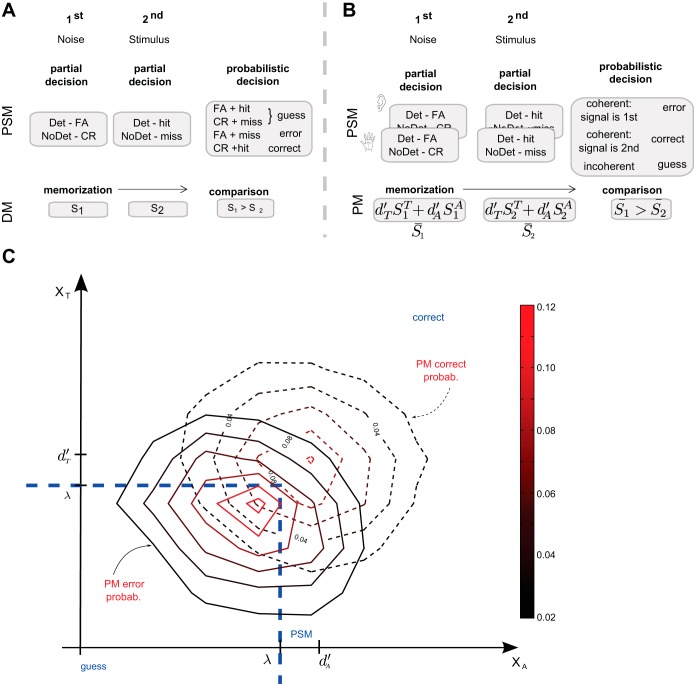Fig. 2.
Schematic representation of 2 models in a 2-interval forced choice tasks (2IFC) for a single modality (A) and audiotactile (B) detection tasks, showing the distributions of the sensory activities (S1 and S2) for the noise and for the stimulus (in B both modalities of the multisensory compound are represented, S1T, S1A, S2T, and S2A). We arbitrarily represented the noise stimulus as being presented first. For the PSM strategy (A and B, top row); after each interval the observer is in 1 of 2 states: detection (Det) or not detection (NoDet). When the stimulus is not presented (1st interval), the observer can make a false alarm (FA) or a correct rejection. When the stimulus is presented (2nd interval), the observer can make a hit or a miss by detecting or not the stimulus, respectively. For an audiotactile stimulus (B), there are 16 possible states, corresponding to the possible combinations of the 4 states of each interval. The final decision is made upon these states with a probabilistic rule. Correct answers are given only when the 2 (A) or 4 (B) states are not in contradiction and correct (i.e., stimulus in 2nd interval); error answers are given only when the 2 (A) or 4 (B) states are not in contradiction, but incorrect (i.e., stimulus in 1st interval); in all the other cases, where at least one of the decision is incoherent with the others, the observer has to guess. According to the difference model (DM; A, bottom row) in the single modality the decision is made upon the comparison of the 2 sensory activities S1 and S2, so the sensory activity of the 1st interval, S1, has to be memorized until after the 2nd interval. According to the PM strategy (B, top row) the decision is made upon the comparison of the weighted sum of the 2 sensory activities (S̄1, S̄2). The weighted sum of the audiotactile sensory activity of the 1st interval, S̄1, has to be memorized until after the 2nd interval. C: decision bounds for PM and PSM (without false alarms) in a detection task with audiotactile stimuli. These boundaries are represented in the same stimulus space as in Fig. 1B, but for this paradigm is more complex to represent the decision, as it depends on the sensory activity during the interval with no stimulus. The PSM's decision bound separate the XT, XA space into 2 zones, where the answer can be correct (1 of the 2 stimuli was detected) or a guess (both stimuli have sensory activity below the threshold). For the PM we depicted the contour plot of the probability distribution for correct (dashed lines) and error (continuous lines) answers. To generate these distributions we simulated the PMs for 104 trials by extracting pseudorandom Gaussian values for the sensory activities.

